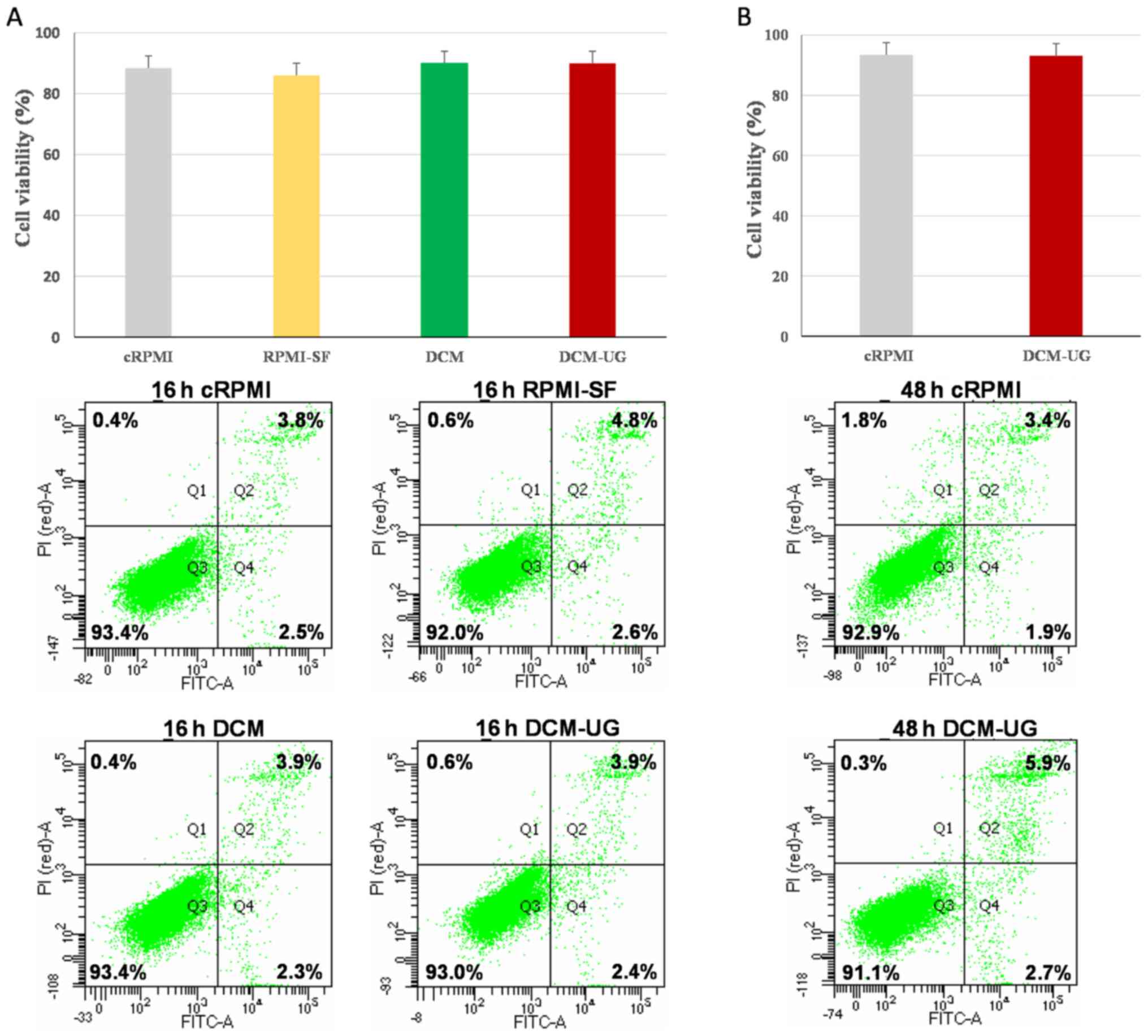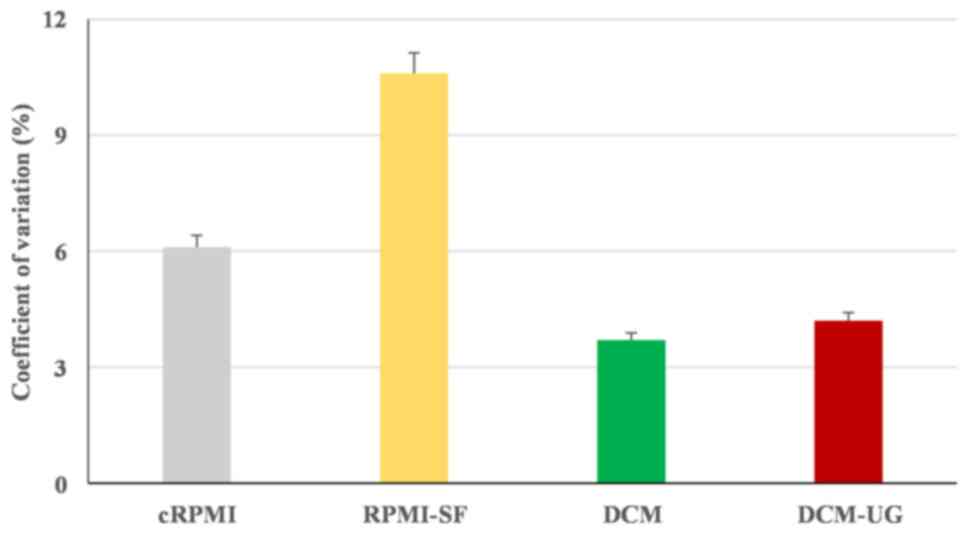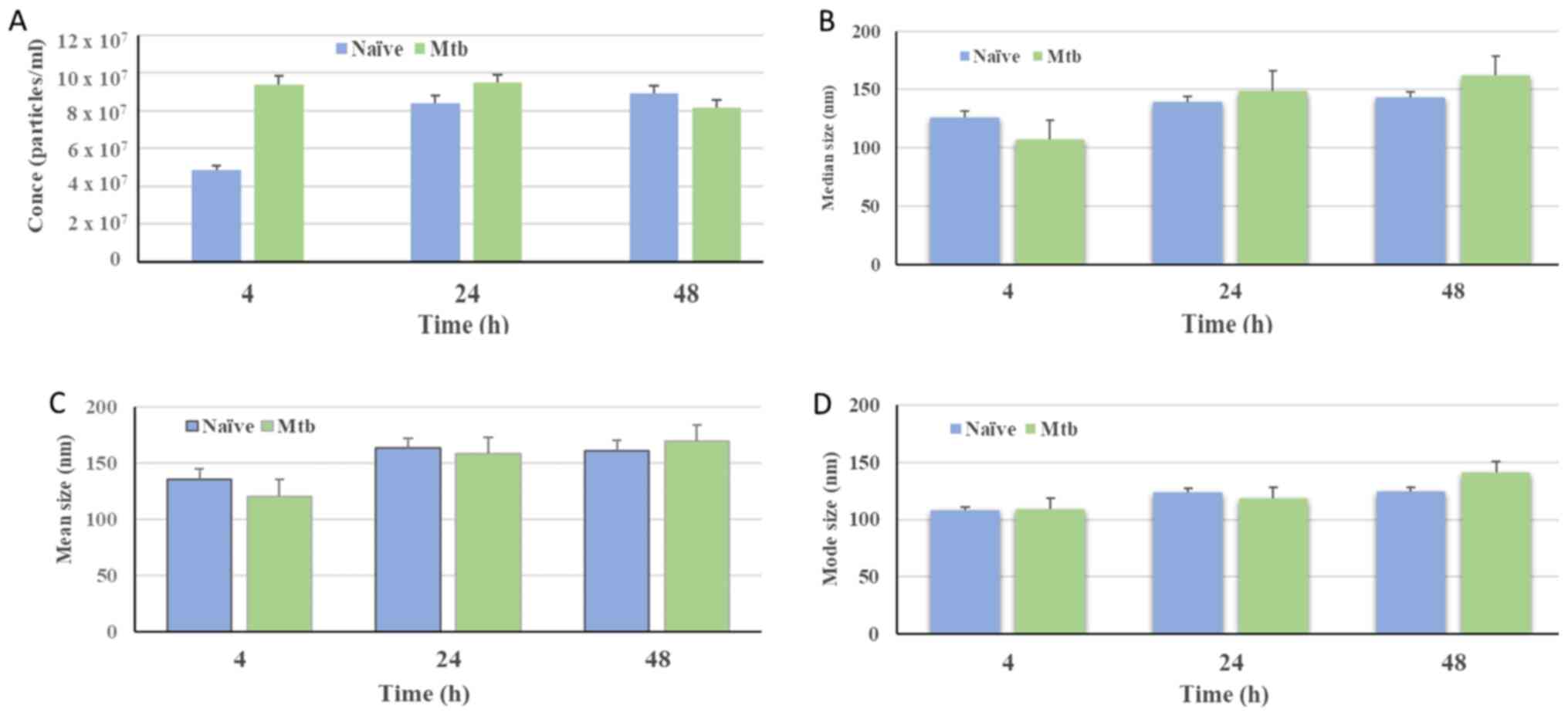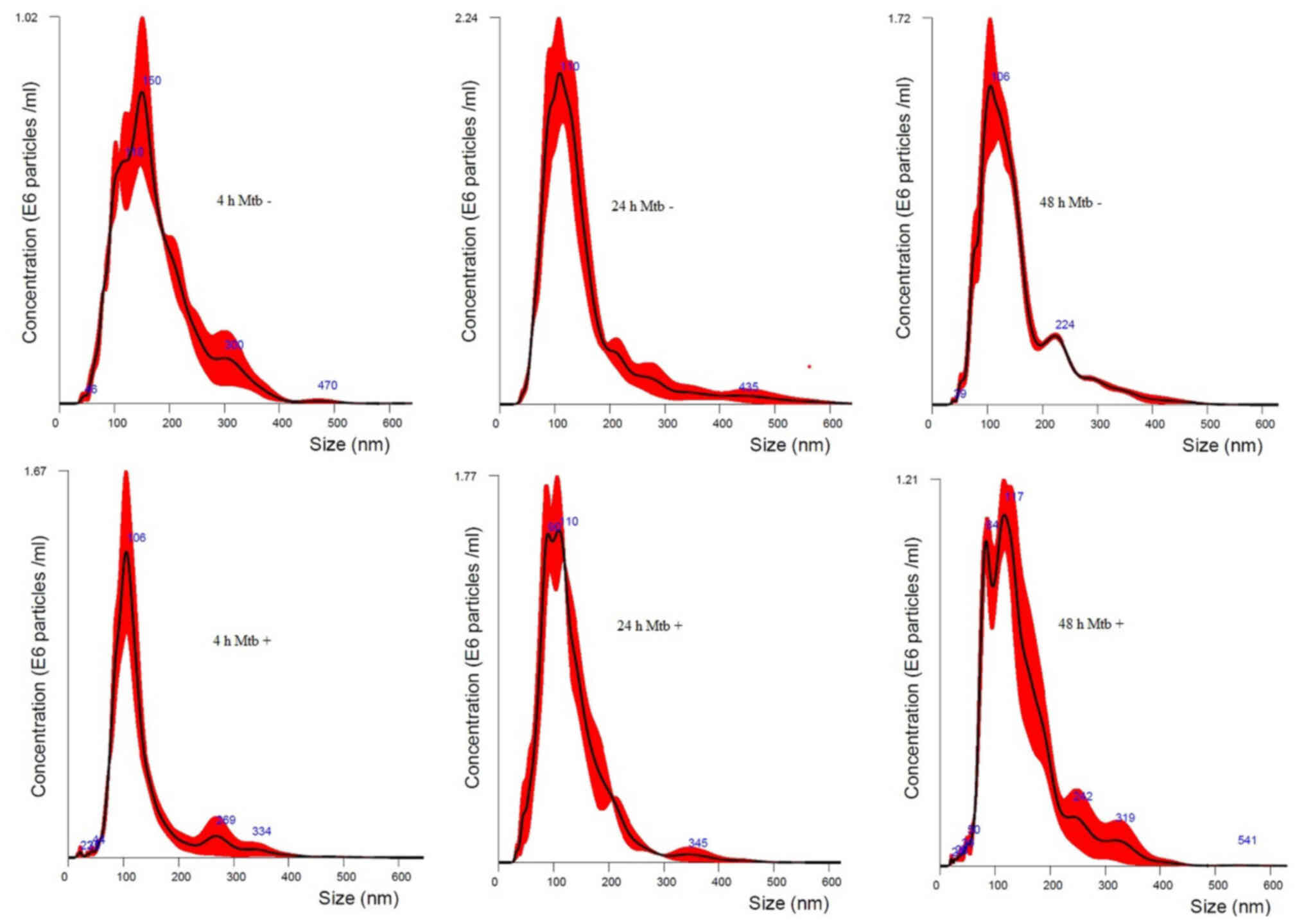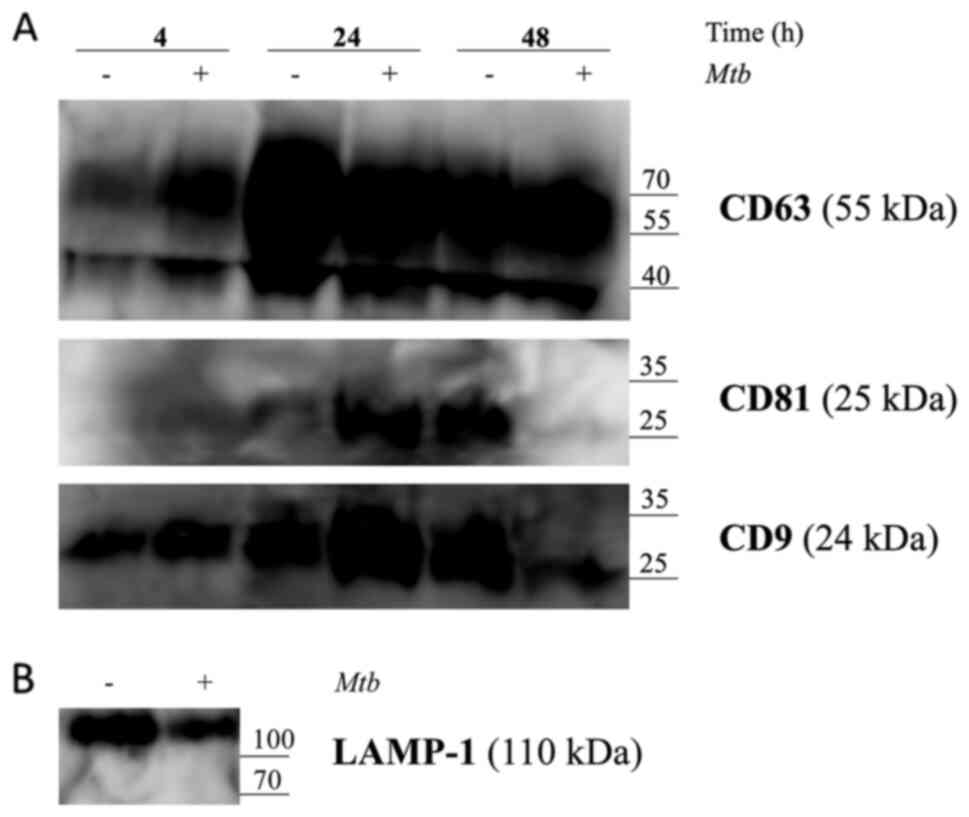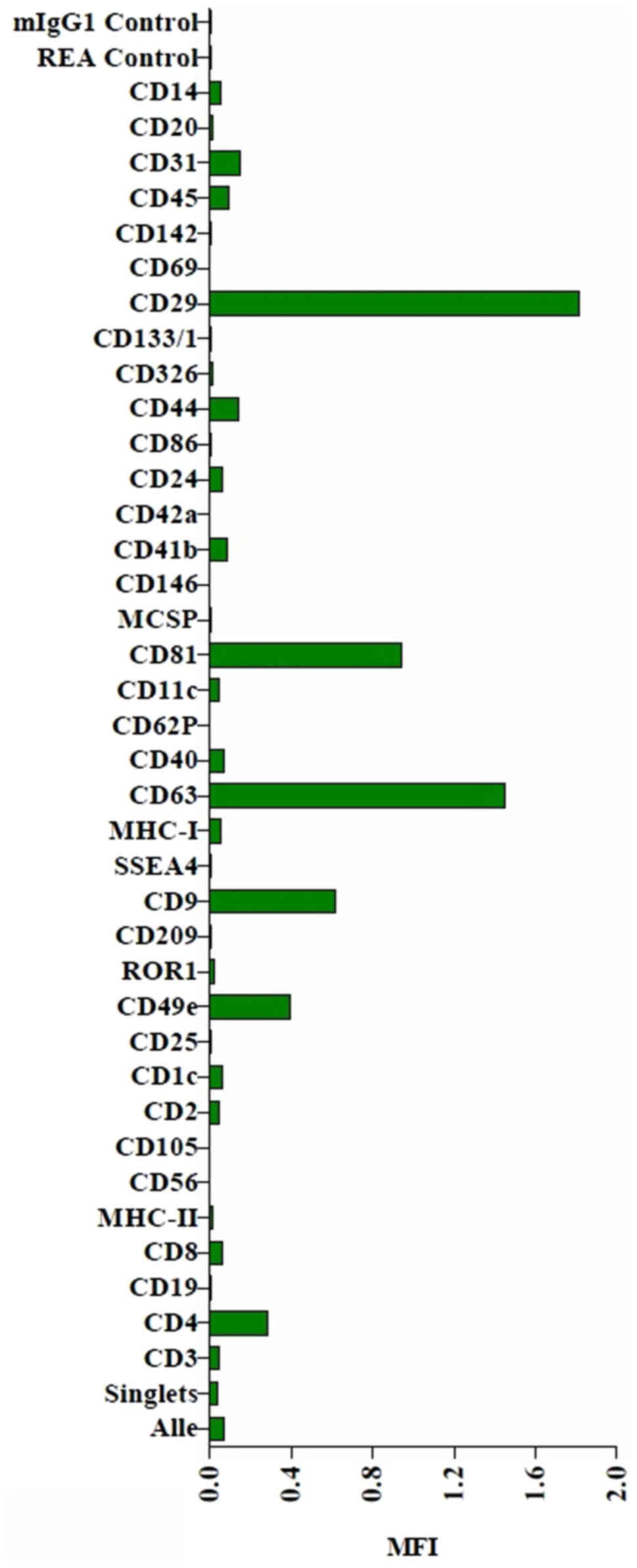Exosomes in serum‑free cultures of THP‑1 macrophages infected with Mycobacterium tuberculosis
- Authors:
- Published online on: September 22, 2021 https://doi.org/10.3892/mmr.2021.12455
- Article Number: 815
-
Copyright: © Biadglegne et al. This is an open access article distributed under the terms of Creative Commons Attribution License.
Abstract
Introduction
Tuberculosis (TB) remains a major health challenge worldwide (1). Global estimates report that, at any time, 25% of the world's population is infected with Mycobacterium tuberculosis (Mtb). If undiagnosed and untreated, 5–10% of patients with latent TB will progress to the condition of active TB (2). Therefore, accurate and reliable diagnostic tests are crucial for the prevention of TB.
Exosomes are minuscule, phospholipid enclosed membrane vesicles ranging from 30–150 nm in size that originate from a variety of different cell types (3,4). These cells are able to release exosomes into their surroundings (5). Exosomes contain and release DNA (3), RNA (5) and proteins (6,7), which are commonly used as exosomal markers, serving major roles in intercellular communication through the transfer of secreted molecules and through direct cell-cell contact (8). Exosomes have been identified in the supernatants of cultured cells and in biological fluids using specific membrane proteins that serve as markers, notably CD9, CD63 and CD81 (9–13). Exosomes have also been shown to be involved in the pathogenesis of various types of infection, and have themselves been suggested to serve a role as valuable biomarkers that may guide different anti infective therapies (14). The identification of easily measurable, accurate and reliable diagnostic markers would be expected to have a significant impact on disease control. Exosomes have biomarker potential, and yet, to fulfil this potential, their careful characterization is required, since components within exosomes vary according to the cell type that they originate from (15). Therefore, the accurate extraction of exosomes from cells and biological fluids is an essential requirement for exosome research, and for ensuring their eventual use in biomedical applications.
Mtb-infected human THP-1 macrophages have been shown to release Mtb molecules within exosomes, as determined from the fact that Mtb, which is an intracellular pathogen, is able to release Mtb protein-containing exosomes (6). Mtb-derived proteins have been detected in cell-culture supernatants from cells infected with the laboratory Mtb strain H37Rv (6) and in the biological fluids of patients with TB (7,14). Exosomes could serve as diagnostic markers for TB since they are carriers of the molecular constituents of mycobacteria (16). Therefore, the present study aimed to investigate the protein composition of exosomes released by Mtb-infected human macrophages.
To meet this end, the tetraspanin family membrane proteins CD9, CD63, CD81 and lysosomal associated membrane protein-1 (LAMP-1) were employed as markers for host-derived molecules. Furthermore, mycobacterial antigen 85 (Ag85) and the Mpt64 protein were selected to evaluate the presence of Mtb molecules within exosomes. The majority of the published studies on exosomes and protein surface markers to date have focused on the use of cells cultured in media supplemented with 10% fetal bovine serum (FBS) (17–19). Abramowicz et al (13) demonstrated that high abundance exosome-contaminating serum proteins are potential sources of contaminants that cause substantial drawbacks in terms of exosome harvest, isolation and processing. Accordingly, a decision was made in the present study to select serum-free ultra-centrifuged dendritic cell medium for the purpose of culturing THP-1 cells for subsequent exosome processing. Consequently, the human monocytic cell line THP-1 was cultured in a serum-free ultracentrifuged CellGenix® GMP DC medium to avoid interference with sera proteins. Upon optimization of a sera free system for the cultivation and infection of human THP-1 macrophages, the exosomes were investigated, principally for their biophysical features, surface markers and their content of mycobacterial proteins following infection.
Materials and methods
Cell culture
The human monocytic cell line THP-1 (kindly provided by the Institute of Clinical Immunology, University of Leipzig, Leipzig, Germany) was maintained in RPMI-1640 medium (Gibco; Thermo Fisher Scientific, Inc.) supplemented with 10% FBS (Invitrogen; Thermo Fisher Scientific, Inc.) and 1% penicillin/streptomycin (Seromed; Biochrom KG), hereafter designated as complete RPMI (cRPMI). To avoid contaminating serum-derived exosomes, four different types of cell-culture media were investigated for their suitability for THP-1 cell cultures. These media were cRPMI, RPMI-1640 medium without 10% FBS (hereafter designated as RPMI SF), CellGenix® GMP DC medium (CellGenix GmbH) that was not ultra-centrifuged (here after designated as DCM) and DCM-UG medium, which was DCM medium that was ultra-centrifuged at 120,000 × g for 20 h to remove particles or events that are found within the size range of exosomes in DCM medium using NanoSight LM10 (Malvern Panalytical Ltd.) (hereafter designated as DCM-UG).
Apoptotic assay
THP-1 cells were seeded at a density of 1×106 cells/ml in 6-well plates in cRPMI, RPMI SF, DCM or DCM-UG media. The cells were incubated either for 16 or 48 h at 37°C in a humidified atmosphere with 5% CO2. Following the incubation, cells were subjected to flow cytometric analysis for assessment of apoptosis and necrosis using an Annexin V-FITC and propidium iodide (PI) staining kit (cat. no. 640914; BioLegend, Inc.). The cells were harvested and washed three times at 350 × g for 5 min with cold phosphate-buffered saline (PBS); subsequently, 200 µl supernatant was resuspended in Annexin binding buffer at a concentration of 1×106 cells/ml, and 100 µl cell suspension was stained with 5 µl Annexin V and 10 µl PI for 15 min in the dark at room temperature. A total of 200 µl Annexin binding buffer was then added, and the extent of apoptosis or necrosis was subsequently analyzed using a BD FACSCanto II flow cytometer and FACSDiva software 8.0.1 (BD Biosciences). Live cells (Annexin-V−/PI−), apoptotic cells (Annexin-V+/PI−) and necrotic cells (Annexin-V+/PI+) were evaluated for each culture condition in triplicate, and the averaged values were then calculated.
Mtb culture and infection of the THP-1 macrophages
The laboratory strain Mtb H37Rv (kindly provided by Professor Stefan H.E. Kaufmann, Max Planck Institute for Infection Biology, Berlin, Germany) was used for these experiments. Bacteria were grown in Middlebrook 7H9 medium (Difco; BD Biosciences) supplemented with 0.2% glycerol, 0.05% Tween-80 (MilliporeSigma) and 10% albumin-dextrose complex (ADC) (BD Biosciences). Mtb cultures were subsequently incubated at 37°C in an orbital shaker (80 rev./min) to avoid clumping. For infection of the THP-1 macrophages, bacteria in the early logarithmic phase were used (when the OD600 of the cells was in the range of 0.4–0.8). THP-1 cells (2–5×105/ml) were seeded into a T75 flask containing 10 ml cRPMI, and the cell population was expanded by sub culturing every 2–3 days. The differentiation of THP-1 monocytes into macrophages was achieved upon stimulation with 50 ng/ml Phorbol-12-myristat-13-acetat (PMA) (Sigma-Aldrich; Merck KGaA), with subsequent overnight incubation and further cultivation for 2 days in cRPMI. Differentiated THP-1 macrophages were infected with Mtb strain H37Rv for 4 h in DCM-UG at a multiplicity of infection (MOI) of 5, and then the cells were either processed for their exosomes or subsequently washed twice with PBS at room temperature and maintained in DCM-UG. Cell culture supernatants were harvested at various time points after infection (4, 24 and 48 h). Naïve samples were processed in parallel with the Mtb-infected samples. The cell culture supernatants were filtered twice through a 0.22-µm filter membrane (Millex GP; MilliporeSigma) and stored at −80°C until use.
Exosome isolation
DCM-UG culture supernatants (10 ml) from Mtb H37Rv-infected (MOI 5) and naïve THP-1 cells were centrifuged at 2,000 × g for 30 min at room temperature to remove dead cells, cell debris and large particles, and subsequently the supernatants were transferred into sterile tubes. Cell culture supernatants (10 ml) were mixed with 5 ml total exosome isolation reagent (TEIR kit; Invitrogen; Thermo Fisher Scientific, Inc.) from cell culture media and mixed thoroughly through vortexing until a homogenous solution was formed. The samples were subsequently incubated at 4°C overnight, and then centrifuged at 4°C at10,000 × g for 1 h. The supernatant was discarded, and the exosome pellet was either resuspended in NaCl buffer [for subsequent nanoparticle tracking analysis (NTA)] or 1X RIPA buffer (Thermo Fisher Scientific, Inc.) with protease inhibitor (Roche Diagnostics) for western blot analysis.
NTA
The concentration and size of exosomes were analyzed via NTA using a NanoSight LM10 (Malvern Panalytical, Ltd.) equipped with a 450 nm laser to determine the size and concentration of isolated particles, according to the manufacturer's protocol. Samples were diluted 1:20 in sterile 0.9% NaCl. Each experimental run was performed in triplicate (n=3), where each capture was made over a 60 sec period with a frame rate of 25 frames/sec and a camera level of 9. For each sample, the nanoparticle size distribution curve, refractive index and the relative nanoparticle concentration of a particular size were recorded, together with the cumulative percentages of nanoparticles. Data were analyzed using NTA 3.0 software (Malvern Panalytical, Ltd.) with a detection threshold of four and a controlled temperature of 25°C.
Western blot analysis
After exosome isolation, the exosome pellets of Mtb H37Rv-infected and naïve THP-1 macrophages were directly lysed in RIPA buffer comprising 25 mM Tris/HCl (pH 7.6), 150 mM NaCl, 1% NP-40, 1% sodium deoxycholate and 0.1% SDS (Invitrogen; Thermo Fisher Scientific Inc.) with the protease inhibitor (Roche Diagnostics) for 15 min at 4°C. Loading buffer (4X LDS; Invitrogen; Thermo Fisher Scientific, Inc.) under reducing or non reducing conditions was added, and the exosome preparation was boiled at 70°C for 10 min. Lysed exosome samples of 40 µl (typically equivalent of 3.x107 vesicles) were then separated on SDS-PAGE (12% gels) under non reducing (CD9, CD63, CD81 and LAMP-1 a positive loading control) and reducing (anti-Ag85 and anti-Mpt64) conditions, and transferred onto PVDF membranes (Cytiva) with a wet blot chamber (Bio Rad Laboratories, Inc.). After transfer, the membrane was blocked with 5% dry milk and 0.1% Tween-20 in 1X TBS for 1 h at room temperature, and then probed overnight at 4°C with the following primary antibodies: CD9 (1:5,000, cat. no. 10626D) CD63 (1:5,000, cat. no. 10628D), CD81 (1:5,000, cat. no. MA5-13548) and LAMP-1 (1:5,000, cat. no. 14-1079-80) (all from Invitrogen; Thermo Fisher Scientific, Inc.), and Ag85 (1:5,000, clone ab36731), Mpt64 (1:1,000, cat. no. ab193435) and His tag Mpt64 protein (1:1,000, cat. no. ab225589) (all from Abcam). Subsequently, HRP conjugated secondary goat anti mouse (1:100,000, cat. no. 31430, Invitrogen; Thermo Fisher Scientific, Inc.) and rabbit anti mouse antibodies (1:5,000, cat. no. ab205718 Abcam) were used. Secondary antibodies were incubated for 1 h in a shaker at room temperature. After a consecutive washing step with 1X TBS/0.1% Tween-20, a washing buffer was removed and a SuperSignal™ West Femto Maximum Sensitivity substrate (Invitrogen; Thermo Fisher Scientific, Inc.) was added. The membrane was exposed to Stella ray test (Xstella software 2.1.8.415) and analyzed using Aida Image Analyzer software 5.0 (all from Raytest Isotopenmessgeräte GmbH).
Multiplex surface markers
Flow cytometric exosome analysis was performed using the MACSPlex Exosome kit, human (Miltenyi Biotec GmbH) according to the manufacturer's overnight incubation protocol. A combined sample volume comprising 175 µl THP-1 exosomes and 15 µl exosome capture beads, which were coated with 37 different antibodies, were added to a well of the microplate and incubated overnight at room temperature in the dark on an orbital shaker (450 rev./min). After washing, 15 µl master mix of anti-CD9-, anti-CD63- and anti-CD81-APC antibodies were added, and the mixture was incubated for 1 h at room temperature on an orbital shaker. Flow cytometric analysis was performed on a BD FACSCanto II flow cytometer and FACSDiva software 8.0.1 (BD Biosciences). After subtracting the values of the control (buffer only) from the measured samples, the median APC-signal intensity of each specific population of single beads was normalized to the average of the anti-CD9, anti-CD63 and anti-CD81 beads. Surface marker values that were below the corresponding control antibody included in the kit, considered as the measurement threshold, were regarded as negative.
Statistical analysis
Experiments were independently repeated at least in triplicates (n=3). Statistical analysis was performed using Microsoft Excel 2016 software (Microsoft Corporation). Additionally, statistically significant differences in measurements between experiments with two groups were determined using a paired Student's t-test, while one way analysis of variance was performed for comparisons between multiple groups. The percentage coefficient of variation (% CV) was calculated to indicate the precision of the cell culture methods using GraphPad Prism version 5 (GraphPad Software, Inc.). Descriptive data analyses were performed to visualize differences within the data. P<0.05 was considered to indicate a statistically significant difference. Error bars in all figures represent the standard error of the mean (± SEM).
Results
Cell culture and assessment of cellular viability by flow cytometry
To circumvent the possible presence of serum derived exosomes, THP-1 cells were cultured in the four different types of media outlined in the Materials and methods section, and cellular viability was assessed at 16 h (Fig. 1A) and 48 h (Fig. 1B) by flow cytometry. Although there were no statistically significant differences between culture methods (P=0.87), flow cytometry for cell growth assessment showed reduced number of viable cells cultured in the RPMI-SF medium compared with the others, and this was confirmed by the highest percentage coefficient value of cRPMI-SF (% CV of 10.6%) (Fig. 2). Overall, all the types of media (cRPMI, RPMI-SF, DCM and DCM-UG) allowed the monocytic cells to replicate over a period of 16 h, but serum-free media resulted in the highest variance amongst the tested media. DCM (% CV of 3.7) and DCM-UG (% CV of 4) were found to be suitable media based on their lower coefficient values. The NTA analysis of DCM medium showed particles/events within the size range of exosomes (data not shown). These events or particles in DCM medium were poorly understood and their sources are also unclear. In this regard, apoptosis and necrosis was not performed at 48 h for DCM and RPMI-SF (due to its highest % CV; Fig. 2). Afterwards, the media cRPMI (control) and DCM-UG were selected for further cell growth at 48 h since the main objective of the present study was to use serum-free medium for further exosome research and analysis. Taken together, these data demonstrated that DCM-UG was consistently the best type of medium in terms of cell viability and subsequent exosome purity, and this was therefore selected for subsequent experiments.
Exosome isolation, size and concentration of isolated vesicles
Subsequently, exosomes were extracted from freshly prepared THP-1 cell cultured supernatants using a precipitation method, and an acceptable number of exosomes were recovered via this process. The size and concentration of the exosomes were then analyzed by NTA using a NanoSight LM10 apparatus. This instrument is able to detect and analyze small particles <30 nm in size by increasing the viscosity of the sample (19). This technology, however, is not able to differentiate exosomes from other synthetic nanoparticles or from large protein aggregates (20).
The concentration (particles/ml) of isolated vesicles was found to be higher than the detection levels, irrespective of the Mtb infection status (Fig. 3A). The particle distribution observed for nanovesicles isolated from naïve THP-1 cells indicated that 50% of the population were below 126.3±8.9 nm in size at 4 h, with subsequent measurements of 138.8±20.8 and 142.5±7.2 nm at 24 and 48 h, respectively. By contrast, for the Mtb-infected THP-1 cells, it was observed that 50% of the particles were below 106.8.2±5.6, 148.5±13.6 and 161.5±14.1 nm in size at the 4, 24 and 48 h times points, respectively (Fig. 3B). In addition, the mean size distribution of NTA measurements of nanovesicles isolated from naïve THP-1 cells was at 136±11.0 nm, 161±12.9 nm and 162±30.8 nm in size at 4, 48 and 24 h times points, respectively. However, for the Mtb-infected THP-1 cells, it was 120±13.5 nm, for 4 h, 160±8.5 nm for 24 h and 171±18.6 nm for 48 h (Fig 3C). Nanovesicles from naïve THP-1 cells at the 4 h incubation time point comprised a population with a lower mode value compared with vesicles obtained from naïve cells incubated for 24 and 48 h. Similarly, nanovesicles isolated from infected macrophages at 48 h presented a higher mode value compared with those detected at 4 and 24 h post-infection (Fig. 3D).
The size of isolated particles from all time points in naïve and infected THP-1 macrophages was found to be <400 nm. Besides, the size distribution of vesicles showed a size range peaked at 106, 110 and 150 nm in size for naïve THP-1 cells at 48, 24 and 4 h and 106, 110 and 117 nm for Mtb-infected THP-1 cells at 4, 24 and 48 h times points, respectively. The majority of the isolated vesicles were within the expected size range of 30–150 nm. Nano tracked particle size distribution curves measured at 4, 24 and 48 h for the Mtb-infected and naïve THP-1 macrophages from one representative experiment out of at least three independently performed experiments is shown in Fig. 4.
Western blot analysis
Isolated exosomes were then subjected to western blot analysis to ascertain the presence of selected exosome markers CD9, CD63, CD81 and LAMP-1 in the conditioned THP-1 cell culture medium supernatant, as per the manufacturer's instructions. The results revealed that CD9, CD63, CD81 and LAMP-1 were expressed in exosomes, both from Mtb H37Rv-infected and naïve macrophages (Fig. 5A and B). His-tag Mpt64 protein was also detected (data has not shown). However, blots run with anti-Ag85 and anti-Mpt64 antibodies did not yield positive signals in exosomes collected from infected THP-1 cells at the exosome input recommended, specifically, 10 ml conditioned cell culture medium supernatant.
Flow cytometry analysis of exosomes
The MACSPlex exosome protein marker analysis of naïve THP-1 cell culture supernatants revealed surface marker profiles characterized by strong signals for the exosome associated markers, CD9, CD63 and CD81. The MACSPlex exosome capture bead data additionally indicated the presence of other markers at intermediate-to-low positive APC fluorescence intensity levels, with the highest intensity shown for CD29, indicating the presence of other positive signals in the particular surface epitope within the exosome population (Figs. 6 and S1).
Discussion
The present study primarily aimed to identify an appropriate particle free culture media amenable for the cultivation of THP-1 cells, thereby enabling isolation of high quality exosomes for further investigations. Apoptotic and necrotic cell death are known to alter the quality of exosomes. Cells maintained under inappropriate experimental conditions, i.e., subjected to nutritional stress subsequent to FBS withdrawal, may undergo cell death (20). Whilst the cell membrane of apoptotic cells remain undamaged, necrotic cells lose their membrane integrity and release endogenous material (13). Such events are critical for establishing exosomes' features, and require careful assessment of the most appropriate conditions, in particular, sera free media that would have a minimal impact on cell viability. In the present study, it was observed that a small proportion of THP-1 monocytes underwent apoptosis and necrosis after 48 h of cultivation in the serum-free, ultracentrifuged dendritic cell medium, DCM-UG. This is consistent with other reports (9,10,13), underlining that isolation of serum-free exosomes from THP-1 cells is possible and that the use of DCM-UG additionally circumvents erroneous results due to decreased cell viability. The present study has reported, to the best of our knowledge for the first time, the suitability of DCM-UG for exosome targeted studies in THP-1 monocytes or macrophages, and has generated a schema for downstream characterization of the exosomes.
Ultracentrifugation has been traditionally employed for the isolation of exosomes; however, this method is time consuming (8–30 h), laborious, requires costly equipment, increases the risk of exosomal damage through the generation of large protein aggregates, and offers variable recovery rates (11,12,15). This method also grossly affects the quality of the isolated exosomes. In the present study, the TEIR kit provided by Thermo Fisher Scientific, Inc. was employed (17), which is a precipitation technique for the isolation of exosomes that provides a higher particle yield within a shorter processing time, which thereby decreases the use of a higher volume of starting material that has been used in previous studies (10,18). NTA, flow cytometric MACSPlex exosome analysis of the THP-1 human monocytic cell line and western blot analysis were also used to characterize and confirm that the isolated vesicles were exosomes. In agreement with previous studies (5,19,21), the aforementioned methodologies allowed for the recovery of intact exosomes at high yields from THP-1 macrophages. Similar results have been reported for the human lung cancer cell line A549 (18), also with the same 10 ml sample volume input (13). The present study also confirmed that the isolated vesicles were exosomes that fell mostly within the size range of 30–150 nm at all time points. The exosomes isolated from naïve and infected macrophages using the TEIR kit, according to the NTA assay, presented comparable concentrations (particles/ml), mean and mode sizes and values that were within the range of those reported by other groups for THP-1 and other cells (10,18). It was observed in the current study that ~50% of the vesicle populations fell below 200 nm in diameter in both the Mtb H37Rv-infected and uninfected THP-1 macrophages. However, vesicles were also observed with wider size ranges that were >200 nm. This probably resulted from the precipitation based techniques that were used for exosome isolation in this study. The TEIR kit also yielded extracellular vesicles (EVs) other than exosomes and aggregates of soluble proteins from cell culture media, and similar findings have been reported by other groups who also employed the precipitation method (18,20,22). The NTA technique does have certain limitations, however, regarding adequate differentiation among vesicles released by precipitation reagents, synthetic nanoparticles, large protein aggregates and biological vesicles (18,23), indicating that the method may overestimate the numbers of exosomes through detecting contaminating proteins that are not associated with exosomes (24).
The present study also characterized the expression of proteins enriched in exosomes, including CD63, CD9 and CD81. All samples expressed CD63 and CD9, similarly to what has been reported previously (25). However, CD81 was detected only in selected samples, at distinct time points in infected and naïve macrophages. The identification of LAMP-1 in the present study was inconsistent with another study (26), and a number of previously published studies have documented a variety of exosome populations based on their surface protein markers (21,27,28). Furthermore, the marker profiles have been shown to vary with the type of origin cell. In the present study, the Mtb antigen Ag85 and Mpt64 protein were not detected in infected THP-1 macrophages. The inability to detect Mtb proteins could have been due to the small sample volume, as only a 10 ml sample was investigated, which therefore may have meant that the amounts of mycobacterial proteins present were below the detection limits of the western blotting technique. Giri et al (29) isolated Ag85 from Mtb-infected J774 cells using western blotting. The absence of Ag85 and Mpt64 protein in Mtb-infected THP-1 cells in the present study may have also been due to an absence of Mtb proteins in the exosomes released under the culture conditions employed in the present study, i.e., a lack of serum factors. On the other hand, the choice of the sampling time points may have had an impact on the abundance of exosomes observed during Mtb infection, with more exosomes containing mycobacterial proteins possibly being released during the late infection. Further investigations are required to elucidate the thresholds for mycobacterial proteins in macrophage derived exosomes, and also the kinetics of detection during in vitro infection.
Flow cytometry analysis is a well-established method that is used to characterize EV subpopulations in cells. In the present study, the presence of CD9, CD63 and CD81 in exosomes released by a human monocytic cell line was investigated by using a multiplex bead-based flow cytometry assay. Predominantly four bead populations, i.e., CD9, CD63, CD81 and CD29, were detected as being strongly positive in the exosomes of THP-1 cell culture supernatants, a finding that is in agreement with a study by Wiklander et al (21), who reported the presence of very strong signals of CD63, CD81, CD29 and CD49e from the cell lines of culture supernatants using flow cytometry. The data obtained in the present study have confirmed that the assay enabled us to detect EV surface markers from a low volume of sample using a fast method.
The strength of this study was the ability to optimize a sera-free system for the cultivation and infection of human THP-1 macrophages for exosome quality and purity. Thus, indicating that DCM-UG could be an alternative sera-free system to analyze exosomes in further study. Despite this strength, the current study has some drawbacks, which are subjects for future studies. As a result of limited resources and time, a higher volume of starting material to further investigate the Mtb proteins over the manufacturers' recommendations for the use of the precipitation reagent was not performed in this study. Besides, this study did not evaluate the shape of the isolated exosomes due to the lack of transmission electron microscope. Another limitation of this study was the lack of LAMP-1 as a positive control at all time points.
In conclusion, the present study provided evidence in support of the fact that DCM-UG may be an alternative approach for generating high purity exosome preparations. These culture conditions allowed for the detection of surface protein markers unique to exosomes in naïve and Mtb-infected THP-1 macrophages. However, more sensitive methods are necessary to further investigate the Mtb proteins in exosome samples obtained from cells maintained in DCM-UG.
Supplementary Material
Supporting Data
Acknowledgements
The authors would like to thank staff of Institute of Clinical Immunology, Medical Faculty, University of Leipzig, D-04103 Leipzig; Dr Roland Weiss for his help in editing figures and his unreserved support for the present study and Ms Katrin Bauer and Ms Kerstin Wenk for their assistance during the present study.
Funding
The present study was funded by the Alexander von Humboldt Foundation.
Availability of data and materials
The datasets used and/or analyzed during the current study are available from the corresponding author on reasonable request.
Authors' contributions
FB was the primary researcher, who conceived and designed the study with guidance from YGJDS, BK, ACR, US and AD. FB performed the laboratory experiments, interpreted the results, conducted data analysis and wrote the manuscript. PR participated in laboratory experiments and contributed reagents. UZ performed the Mtb infection studies. FB and PR confirm the authenticity of all the raw data. FB, BK, ACR AD and US searched for relevant literature. PR, YGJDS, BK, ACR, AD and US reviewed the initial and final drafts of the manuscript. All authors read and approved the final manuscript.
Ethics approval and consent to participate
Not applicable.
Patient consent for publication
Not applicable.
Competing interests
The authors declare that they have no competing interests.
References
|
World Health Organization (WHO), . Global Tuberculosis Report 2018. WHO; Geneva: pp. 2312018 | |
|
World Health Organization (WHO), . WHO Guidelines on Tuberculosis Infection Prevention and Control: 2019 Update. WHO; Geneva: pp. 622019 | |
|
van der Pol E, Böing AN, Harrison P, Sturk A and Nieuwland R: Classification, functions, and clinical relevance of extracellular vesicles. Pharmacol Rev. 64:676–705. 2012. View Article : Google Scholar : PubMed/NCBI | |
|
Lee S-S, Won J-H, Lim GJ, Han J, Lee JY, Cho K-O and Bae Y-K: A novel population of extracellular vesicles smaller than exosomes promotes cell proliferation. Cell Commun Signal. 17:952019. View Article : Google Scholar : PubMed/NCBI | |
|
Patel GK, Khan MA, Zubair H, Srivastava SK, Khushman M, Singh S and Singh AP: Comparative analysis of exosome isolation methods using culture supernatant for optimum yield, purity and downstream applications. Sci Rep. 9:53352019. View Article : Google Scholar : PubMed/NCBI | |
|
Diaz G, Wolfe LM, Kruh-Garcia NA and Dobos KM: Changes in the Membrane-Associated Proteins of Exosomes Released from Human Macrophages after Mycobacterium tuberculosis Infection. Sci Rep. 6:379752016. View Article : Google Scholar : PubMed/NCBI | |
|
Kruh-Garcia NA, Wolfe LM, Chaisson LH, Worodria WO, Nahid P, Schorey JS, Davis JL and Dobos KM: Detection of Mycobacterium tuberculosis peptides in the exosomes of patients with active and latent M. tuberculosis infection using MRM-MS. PLoS One. 9:e1038112014. View Article : Google Scholar : PubMed/NCBI | |
|
Zhang Y, Liu Y, Liu H and Tang WH: Exosomes: Biogenesis, biologic function and clinical potential. Cell Biosci. 9:192019. View Article : Google Scholar : PubMed/NCBI | |
|
Lobb RJ, Becker M, Wen SW, Wong CSF, Wiegmans AP, Leimgruber A and Möller A: Optimized exosome isolation protocol for cell culture supernatant and human plasma. J Extracell Vesicles. 4:270312015. View Article : Google Scholar : PubMed/NCBI | |
|
Zeringer E, Li M, Barta T, Schageman J, Pedersen KW, Neurauter A, Magdaleno S, Setterquist R and Vlassov AV: Methods for the extraction and RNA profiling of exosomes. World J Methodol. 3:11–18. 2013. View Article : Google Scholar : PubMed/NCBI | |
|
Rosas LE, Elgamal OA, Mo X, Phelps MA, Schmittgen TD and Papenfuss TL: In vitro immunotoxicity assessment of culture-derived extracellular vesicles in human monocytes. J Immunotoxicol. 13:652–665. 2016. View Article : Google Scholar : PubMed/NCBI | |
|
Tauro BJ, Greening DW, Mathias RA, Ji H, Mathivanan S, Scott AM and Simpson RJ: Comparison of ultracentrifugation, density gradient separation, and immunoaffinity capture methods for isolating human colon cancer cell line LIM1863-derived exosomes. Methods. 56:293–304. 2012. View Article : Google Scholar : PubMed/NCBI | |
|
Abramowicz A, Marczak L, Wojakowska A, Zapotoczny S, Whiteside TL, Widlak P and Pietrowska M: Harmonization of exosome isolation from culture supernatants for optimized proteomics analysis. PLoS One. 13:e02054962018. View Article : Google Scholar : PubMed/NCBI | |
|
Singhal N, Sharma P, Kumar M, Joshi B and Bisht D: Analysis of intracellular expressed proteins of Mycobacterium tuberculosis clinical isolates. Proteome Sci. 10:142012. View Article : Google Scholar : PubMed/NCBI | |
|
Théry C, Amigorena S, Raposo G and Clayton A: Isolation and characterization of exosomes from cell culture supernatants and biological fluids. Curr Protoc Cell Biol Chapter. 3:Unit 3.22. 2006.doi.org/10.1002/0471143030.cb0322s30. PubMed/NCBI | |
|
Hu X, Liao S, Bai H, Wu L, Wang M, Wu Q, Zhou J, Jiao L, Chen X, Zhou Y, et al: Integrating exosomal microRNAs and electronic health data improved tuberculosis diagnosis. EBioMedicine. 40:564–573. 2019. View Article : Google Scholar : PubMed/NCBI | |
|
Biadglegne F, König B, Rodloff AC, Dorhoi A and Sack U: Composition and Clinical Significance of Exosomes in Tuberculosis: A Systematic Literature Review. J Clin Med. 10:E1452021. View Article : Google Scholar | |
|
Tang Y-T, Huang Y-Y, Zheng L, Qin S-H, Xu X-P, An T-X, Xu Y, Wu Y-S, Hu X-M, Ping B-H, et al: Comparison of isolation methods of exosomes and exosomal RNA from cell culture medium and serum. Int J Mol Med. 40:834–844. 2017. View Article : Google Scholar : PubMed/NCBI | |
|
Arteaga-Blanco LA, Mojoli A, Monteiro RQ, Sandim V, Menna-Barreto RFS, Pereira-Dutra FS, Bozza PT, Resende RO and Bou-Habib DC: Characterization and internalization of small extracellular vesicles released by human primary macrophages derived from circulating monocytes. PLoS One. 15:e02377952020. View Article : Google Scholar : PubMed/NCBI | |
|
Atha DH and Ingham KC: Mechanism of precipitation of proteins by polyethylene glycols. Analysis in terms of excluded volume. J Biol Chem. 256:12108–12117. 1981. View Article : Google Scholar : PubMed/NCBI | |
|
Wiklander OPB, Bostancioglu RB, Welsh JA, Zickler AM, Murke F, Corso G, Felldin U, Hagey DW, Evertsson B, Liang X-M, et al: Systematic Methodological Evaluation of a Multiplex Bead-Based Flow Cytometry Assay for Detection of Extracellular Vesicle Surface Signatures. Front Immunol. 9:13262018. View Article : Google Scholar : PubMed/NCBI | |
|
Helwa I, Cai J, Drewry MD, Zimmerman A, Dinkins MB, Khaled ML, Seremwe M, Dismuke WM, Bieberich E, Stamer WD, et al: A Comparative Study of Serum Exosome Isolation Using Differential Ultracentrifugation and Three Commercial Reagents. PLoS One. 12:e01706282017. View Article : Google Scholar : PubMed/NCBI | |
|
Gercel-Taylor C, Atay S, Tullis RH, Kesimer M and Taylor DD: Nanoparticle analysis of circulating cell-derived vesicles in ovarian cancer patients. Anal Biochem. 428:44–53. 2012. View Article : Google Scholar : PubMed/NCBI | |
|
Caradec J, Kharmate G, Hosseini-Beheshti E, Adomat H, Gleave M and Guns E: Reproducibility and efficiency of serum-derived exosome extraction methods. Clin Biochem. 47:1286–1292. 2014. View Article : Google Scholar : PubMed/NCBI | |
|
Keller BO, Sui J, Young AB and Whittal RM: Interferences and contaminants encountered in modern mass spectrometry. Anal Chim Acta. 627:71–81. 2008. View Article : Google Scholar : PubMed/NCBI | |
|
Smith VL, Cheng Y, Bryant BR and Schorey JS: Exosomes function in antigen presentation during an in vivo Mycobacterium tuberculosis infection. Sci Rep. 7:435782017. View Article : Google Scholar : PubMed/NCBI | |
|
Koliha N, Wiencek Y, Heider U, Jüngst C, Kladt N, Krauthäuser S, Johnston ICD, Bosio A, Schauss A and Wild S: A novel multiplex bead-based platform highlights the diversity of extracellular vesicles. J Extracell Vesicles. 5:299752016. View Article : Google Scholar : PubMed/NCBI | |
|
Brahmer A, Neuberger E, Esch-Heisser L, Haller N, Jorgensen MM, Baek R, Möbius W, Simon P and Krämer-Albers E-M: Platelets, endothelial cells and leukocytes contribute to the exercise-triggered release of extracellular vesicles into the circulation. J Extracell Vesicles. 8:16158202019. View Article : Google Scholar : PubMed/NCBI | |
|
Giri PK, Kruh NA, Dobos KM and Schorey JS: Proteomic analysis identifies highly antigenic proteins in exosomes from M. tuberculosis-infected and culture filtrate protein-treated macrophages. Proteomics. 10:3190–3202. 2010. View Article : Google Scholar : PubMed/NCBI |



